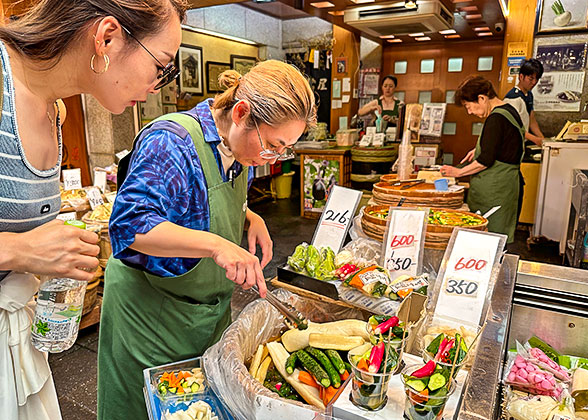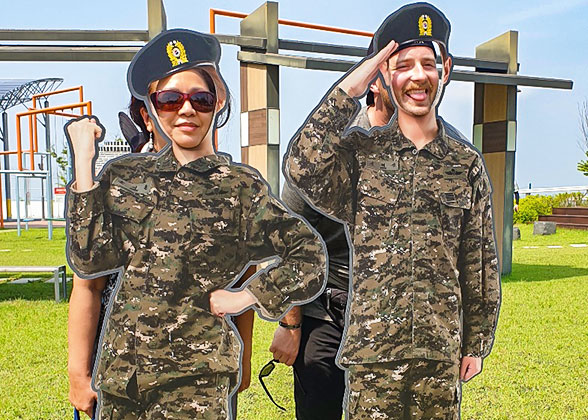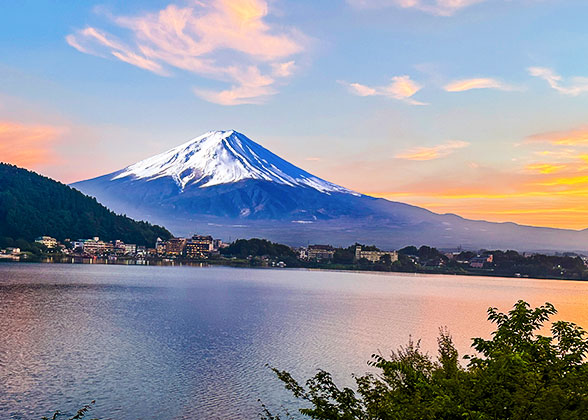Day 1: Arrival in Seoul, Airport Pick-up
Welcome to Seoul, the capital city of South Korea! Upon your flight landing at Incheon International Airport, your private driver will warmly greet you and then transfer you to the well-selected hotel in downtown Seoul in 1.5 hours. After check-in, you could have a good rest at the hotel or step out to explore the surroundings on your own.
► Recommendations for Early Arrivals
Your hotel is near Namdaemun Market, a 600-year-old traditional market where you could find almost everything including daily necessities, clothes, accessories, souvenirs, and a variety of authentic local food. The must-eats are the knife-cut noodles of Hansunja Son Kalguksu at Kalguksu Alley and the spicy braised hairtail stew of Hairtail Alley. After having dinner, you could also sample some of the most popular street snacks like dried strawberries and hotteok (sweet pancakes).
► Tips on Money Exchanging
The official currency of South Korea is Korean Won (KRW). One US dollar equals about 1,360 Korean Won. Airport counters offer 24-hour currency exchange service, but the exchange rate may not be favorable. Finding a WOW Exchange machine in Seoul to get some wons at the best exchange rates could be the most convenient choice for you. You could use your cards like Visa, MasterCard and American Express in most of the stores, malls, and supermarkets across the country, but it’s still recommended to exchange some cash in case you want to buy something from the street vendors.
► How to Get around Seoul
The public transportation of South Korea is very efficient. Getting around by bus or subway is cheaper and more convenient than by taxi. If you want to soak up the city’s atmosphere after settling down, getting a T-Money card at the airport, subway station or a convenience store is highly recommended. It costs KRW 2,500 (approximately USD 2) and is easy to top up, so you don’t need to add too much money to your card at one time. T-Money card can be used to pay for public transportation as well as small purchases at some shops, cafes and restaurants.
Accommodation: Fraser Place Namdaemun Seoul (4 stars) or similar
|
Day 2: Seoul City Highlights: Gyeongbokgung Palace, Bukchon Hanok Village & Cheonggyecheon Park
This morning, your English-speaking driver guide will pick you up at the hotel. Your South Korea tour starts when the car passes by the Presidential Residence, known as the Blue House. Our first stop is Gyeongbokgung Palace, which was first built in 1395 as the royal palace of the Joseon Dynasty (1392-1910). Stepping into Gyeongbokgung Palace, you may find it has the similar architectural style to the ancient imperial palaces in China and Japan. That is because China’s traditional culture has been influencing the neighboring countries for over 2,000 years. Compared with the brightly colored roof tiles and intricate decorations of Chinese palaces, Korean ancient palaces feature a smaller scale, gray roofs, and the red and blue color scheme. If interested, you may rent a Hanbok, the traditional Korean clothing before visiting Gyeongbokgung Palace, and create some beautiful memories to your tour. Changing of the Guard ceremony takes place in front of the Gwanghwamun Gate every day. If luckily, you could get a glimpse of the ancient ritual in the royal palace during the Joseon Dynasty. To the east of the secluded Hyangwonjeong Pavilion lies the National Folk Museum, which presents tens of thousands of daily life items of Korean people, including clothing from the Joseon Dynasty, agricultural tools, etc. giving an insight into what life in the past was like in Korea.
► Tip: If it happens to be a Tuesday, the palace will be closed and we will visit Changdeokgung Palace instead, which is also one of the “5 Grand Palaces of Seoul” and one of the UNESCO World Heritage sites in South Korea.
After touring the palaces, let’s proceed to the nearby Samcheong-dong Street, one of the most stylish and artistic areas in Seoul, where you could explore the antique Hanok houses of cafes, restaurants and delicate galleries. Next, we’ll visit the famous Bukchon Hanok Village. Following the guide’s footprint, explore this representative residential neighborhood of the civil and military officials 600 years ago. Backed by towering skyscrapers, 900 traditional Hanok houses show the cultural and architectural heritage of Seoul. What you should note here is that Bukchon is a real neighborhood and visitors are advised to speak low and be respectful in order not to disturb the life of the residents.
We’ll then head to Insadong Antique Alley, a street stuffed with galleries, tea houses, and stores selling crafts and antiques. Discover unique exhibitions of Korean paintings and sculptures, and delve into the traditional art of Korea. Also, don’t miss the various street snacks, especially the Hotteok (sweet pancake) and Bungeoppang (fish-shaped pastry). Satisfy your taste buds with the traditional Korean flavors. In the late afternoon, make our way to Cheonggyecheon Stream Park. The 10-kilometer-long Cheonggyecheon Stream meanders through the heart of Seoul city, carrying the memories of generations of citizens. The limpid, clean water provides a refreshing retreat for locals, and of course, young lovers. Take a leisurely stroll, and explore the arches of the graceful bridges and the stepping stones across the water. Or just sit by the calm water, and enjoy the peaceful scenes of mandarin ducks playing in the water and egrets catching fish for dinner. After all the sightseeing, the guide will send you back to your hotel or the nearby Myeongdong Shopping District according to your needs.
► Recommendation for Dinner (at your own expense):
Wangbijip is one of the most popular barbecue restaurants in Myeongdong area and there are several outlets, among which Wangbijip Myeongdong Main Store (26 Myeongdong 8ga-gil, Jung District, Seoul) is the most renowned. It offers premium charcoal-grilled meat including a large variety of beef dishes, coming with free side dishes like the crunchy kimchi. You could roast the meat yourself and enjoy the fun of barbecue with your friends or family. The average cost of the restaurant is around USD 17.
Meals: Breakfast
Accommodation: Fraser Place Namdaemun Seoul (4 stars) or similar
|
Day 3: Seoul: Tour DMZ & War Memorial of Korea
After breakfast, leave for the Demilitarized Zone (DMZ) to witness the Korean War history. DMZ refers to the North and South Korea military boundary where the armistice was signed in 1953. It is 4 kilometers (2.5 mi.) wide and stretches for 250 kilometers (155 mi.). Follow the guide to visit Imjingak Park, where you could see the Freedom Bridge and the Peace Bell, reminding the world the fierce battle millions of soldiers fought 70 years ago. A unified nationality was split into two countries, causing disasters and leaving long-lasting impacts on hundreds of thousands of families. Behind the semblance of peace is the heavy ambiance of war, and DMZ remains the most dangerous border in the world that only animals can roam freely. Walk into the Third Tunnel, which is said to be dug by North Korea for military use in 1978, uncover the past, and witness the history and tension of the two Korean countries. For most of us, North Korea could be one of the most mysterious countries in the world. The Dora Observatory here provides a precious chance for you to get a view of the reclusive land from the south. You may even see the national flag waving in the city of Kaesong through binoculars if it’s sunny.
► Tips for Your DMZ Visit: Bring your passport and strictly follow the rules since it’s a heavily guarded zone. Photography is strictly forbidden in certain areas, so always ask your tour guide before taking a photo.
Thereafter, you’ll be transferred back to the city and visit War Memorial of Korea. The museum was set up to honor and commemorate the sacrifices of martyrs who fought during Korea’s military conflicts, particularly the Korean War. As one of the world’s largest war memorials, it houses over 17,000 war-related items, including combat weapons like aircrafts, tanks and submarines from various wars, as well as the replicas of battleships of the Joseon Dynasty, attracting history lovers and military fans from all over the world. After the visit, you’ll be escorted back to the hotel.
► Recommendations for the Night in Seoul: (on your own)
To ease the heavy mood caused by daytime visit, you are recommended to take a relaxing 40-minute Han River cruise (E-Land Cruise), enjoying Seoul’s breathtaking cityscape. Overlook Namsan Seoul Tower and Banpo Bridge, and immerse yourself in the intoxicating live performance on the cruise. A Sunset Cruise costs KRW 22,900 (USD 16.7) and a Moonlight Music Cruise costs KRW 27,900 (USD 20). Also there are some dinner cruise packages available. If you want to experience the vibrant Seoul nightlife, one of the must-go areas is Itaewon, where the Eastern and Western cultures meet. If you have interest in Korean dramas, you may have seen the bustling streets of Itaewon through the TV series Itaewon Class. The main street is filled with cafes, shops, bars and restaurants. Enjoy a wonderful Korean-style barbecue dinner at MapleTree House. After dinner, explore the diverse bars such as the rooftop Casa Corona and Southside Parlor. Choose a seat on the open-air terrace on the roof, and have some craft cocktails in the chic ambience.
Meals: Breakfast
Accommodation: Fraser Place Namdaemun Seoul (4 stars) or similar
|
Day 4: Move to Busan by Bullet Train; Visit Jagalchi Market, BIFF Square & Gamcheon Culture Village
This morning, let’s take a 2.5-hour KTX bullet train to Busan. Upon arrival, follow the guide to start the Busan tour from Jagalchi Market. Born in 1889, it is one of the largest seafood markets in South Korea. Walking from the outdoor stalls to the indoor market, you could see the neatly-placed seafood and hear the vendors’ enthusiastic hawking. Since most of the vendors are female, local people usually call them “Jagalchi Ajumeoni” which indicates married woman in Korean. On the second floor of the market, there are restaurants that cook fresh fish for diners. Also you could get a panoramic view of the ships in the fishing port and the blue sea from here. Next, take a stroll at BIFF Square, which was built in 1996 to hold Busan International Film Festival, one of the most significant film festivals in Asia. A lot of handprints of famous directors and actors who have attended the film festival over decades are embedded on the grounds of the square. It will be fun to spot some handprints from the stars or idols you know. Besides, don’t miss the mouth-watering street food of BIFF Square. Sample some Tteokbokki (spicy rice cakes), Kimbap (seaweed rice rolls) or fish cake skewers.
Then, visit Gukje Market, which is literally International Market with more than 690 stores. It is the largest traditional market in Busan with a history of over 80 years. A wide range of goods could be found in this busy market, including clothing, bags and cases, accessories, souvenirs, and everyday household items. Gukje Market is also a good place to hunt for vintage clothing. The Vintage Alley is packed with shops and stalls selling affordable second-hand clothes. After that, we will spend some time exploring Gamcheon Culture Village. Around 70 years ago, Gamcheon was actually a slum built on the hillside by war refugees. In 2009, the government, local artists and residents began to renovate the houses, and transformed it into a vibrant artistic village with colorful walls and unique artworks. One of the most Instagram-worthy locations is the Little Prince and the Fox statues. Overlooking the whole village, the statues offer a perfect panoramic view and let people rediscover their inner child. Cafes and snack bars are scattered around the village for you to take a break and enjoy the impressive street art. At Last, you’ll be escorted to the hotel.
Meals: Breakfast
Accommodation: ASTI Hotel Busan Station (4 stars) or similar
|
Day 5: Busan to Gyeongju: Visit Bulguksa Temple & Daereungwon Tombs; Back to Seoul by Bullet Train
In the morning, the driver guide will transfer you to Gyeongju by private car. Located in the southeast of South Korea, Gyeongju was the capital of Silla Kingdom (57 BCE-668 AD) in ancient times and houses the largest number of historical sites in the country. We will first visit the UNESCO World Heritage site Bulguksa Temple built in 751 AD. It was one of the most important Buddhist sanctuaries during the Silla Dynasty, but was almost destroyed several times in the past 1,200 years. Although the reconstructed temple is not as large as the original one, a lot of significant ancient structures like stone Buddha statues, the pair of Cheongungyo Bridge and Baegungyo Bridge are well-preserved, showcasing the exquisite artistic aesthetic and architectural techniques. Along with Bulguksa Temple, Seokguram Grotto, built of granite stones on the slope of Mount Tohamsan, is also a part of the world heritage site. Marvel at the magnificent sitting statue of the Enlightenment Buddha with halo-like carvings behind him. The Buddha statue and the statues of bodhisattvas and other deities, with a serene meditative expression, sacredly look at the worshippers. They are all considered some of the most precious masterpieces of Buddhist art in the world. Please note that photography is not allowed in the grotto.
Next, visit the Daereungwon Tomb Complex, a heritage park with 23 ancient royal tombs including Cheonmachong Tomb built between the 5th and 6th century AD. Cheonmachong, which is “heavenly horse tomb” in Korean, got its name from the painting of a horse excavated inside. It is the only existing painting from the Silla Dynasty. Over 10,000 artifacts like gold accessories and pottery were discovered in the tombs of Daereungwon, among which the most striking one is Korea’s largest and finest gold crown.
Our next stop is Cheomseongdae Observatory, another World Heritage site in Gyeongju, which stands as one of the oldest existing astronomical structures in Asia. The observatory was built with a total of 362 granite stones and has 27 tiers, with a height of 9.17 meters (30 ft.). It was built in 634 during the reign of Queen Seondeok (ruled from 632 to 647) - the first female ruler of Korea. There was no weather forecast in ancient times, so people were highly dependent on the observations of the stars and sky to determine the best time for seeding. It was also used to predict the fortune of the country. Now, Cheomseongdae Observatory is surrounded by gardens, and visitors have the chance to appreciate sea of flowers like tulips, sunflowers and hydrangeas in different seasons. At the end of today’s cultural tour, we will stroll around Hwangnidan-gil Street, one of the most nostalgic districts in Gyeongju with a lot of old Hanok houses from the 1960s and 1970s. The narrow streets are lined with dazzling restaurants, cafes and photo shops. Some of the must-try snacks are the cute Gyeongju 10 Won Bread and corn-flavored ice cream. Late in the afternoon, board the KTX bullet train back to Seoul in 2.5 hours. Upon arrival, the private driver will be right there waiting to transfer you to the hotel.
Meals: Breakfast
Accommodation: Fraser Place Namdaemun Seoul (4 stars) or similar
|
Day 6: Departure from Seoul, Airport See-off
This morning, your private driver will take you to the airport for your flight to next destination. Wish you a nice journey!
► If you feel that the tour is not enough and want to further explore this charming country, just tell us to extend it to other destinations such as the volcanic Jeju Island. If you want to dig deep into East Asian culture and history and discover Japan and China, this itinerary is ready to be customized according to your preference.
Meals: Breakfast
|


